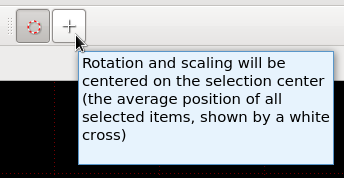Scaling items
Selected items can be scaled by hitting the 'S' key.
This changes the control state to 'scaling', as can be seen from the status bar.

While in the scaling control state the selected objects will scale with the mouse around either
the selection center, or the cursor, depending on the current scaling center setting.
You can hit Escape to cancel the change and exit the scaling state.
To confirm the new scale for the items, click the left mouse button.
While scaling, you can hold down the Ctrl key to make the scale jump in discrete steps instead
of moving smoothly, or hold down Shift to reduce the movement by a factor of ten for fine control.
The step size for the Ctrl key movement can be changed in the Options dialog under the Controls tab.
Scaling center setting
Scaling occurs around a focal point which can be either the selection center, or the cursor.
This setting can be switched between by hitting the 'S' key again during scaling, or by using
the button in the toolbar.

The selection center is the average point of all the selected items, shown by a thin white cross.
Scaling around this is useful when you want to scale without really moving the selection as a whole.
The cursor is the red and white striped circle marker which can be placed
at any position in the scene.
Constraining scaling to one axis
Pressing 'X' or 'Y' while scaling will cause the change to be restricted to that axis.
A red or green line will be shown while in this state. You can exit this state by hitting the same
key again, or switch between axes by hitting the key of the other axis.

Scaling across views
If you have more than one view of the same scene, you will see the scaling occurring in all
views of that scene, and you can move the mouse into another view to control the scaling there.
In most cases this is not very useful, but occasionally it can be handy to make fine adjustments.



